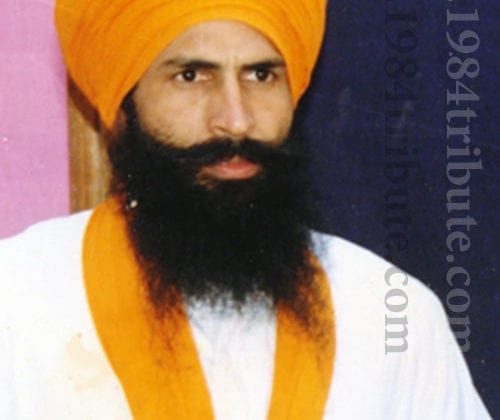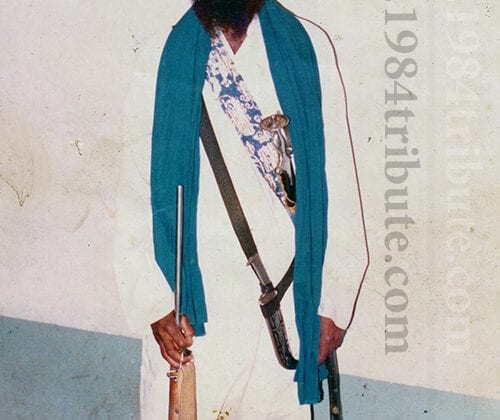Shaheed Bibi Upkar Kaur Khalsa
Shaheed Bibi Upkar Kaur Khalsa
All India Sikh Students Federation (President of Women’s Wing)
Martyrs of June 1984
In 2015, the 1984tribute.com team released at photo of one of the Shaheed Singhnia from the battle of Amritsar, in June 1984. The photo was of Shaheed Bibi Upkar Kaur, the President of All India Sikh Student Federation (Women’s Wing). Since, we have tried our best to get in contact with the family of Shaheed Bibi Upkar Kaur and write about her life, her involvement in the Sikh struggle for freedom. With the blessings of the Sikh Gurus, we were fortunate enough to meet Singhs and Singhnia who had spent time with Shaheed Bibi Upkar Kaur and gather information on her life and martyrdom. After years of research, we present to you the biography of Shaheed Bibi Upkar Kaur.
Bibi Upkar Kaur was born in the year 1962 to the blessed womb of Mata Bakshish Kaur and in the house of father, Sardar Meetpal Singh in the district of Karnal, Haryana. During her college years she became a member of the All India Sikh Students Federation. From a young age, Bibi Upkar Kaur was a firm believer in her faith and devoted to the Sikh way of life. Joining the Sikh Student Federation further reinforced her dedication and she embraced Sikhi wholeheartedly. Bibi Upkar Kaur would organise many Gurmat Camps to preach and spread the word of Sikhi. This was done under the leadership of Bhai Amrik Singh Ji Khalsa who was the leader and founder of the All India Sikh students Federation at the time. Bibi Upkar Kaur was a very influential speaker and delivered with such conviction that anyone listening to her would feel and believe in the passion in which she spoke. Bibi Upkar Kaur backed up her speeches and dialogue with her ever extensive knowledge of Gurbani, Sikh history and Sikh principles.
In 1982, within a very short time scale Bibi Upkar Kaur had established many female units of the Sikh Student Federation in Punjab. Her hard work paid off when Bhai Amrik Singh Ji Khalsa appointed her as the leader of the Women’s Wing for the All-India Sikh Students Federation. From the time the Dharam Yudh Morcha was initiated by Sant Jarnail Singh Ji Khalsa Bhindranwale, Bibi Upkar Kaur contributed massively and worked tirelessly to encourage Sikh women to understand the state of oppression, to support the cause and fight for the freedom of Khalistan. Bibi Upkar Kaur signed-up thousands of young females to join the organisation. Countless times during the Dharam Yudh Morcha, Sikh women gave themselves in for self-arrest. Bibi Upkar Kaur herself was feared by the police due to her unlimited bravery.
On 3rd June 1984, when the Indian army had surrounded the Sri Harmandir Sahib complex, Bibi Upkar Kaur and her group of women were situated by Baba Atal Rai Sahib and Akaal Rest House. On the morning of 4th June, the Indian army made the first attack on the most sacred and holiest places of the Sikhs. From their position, Bibi Upkar Kaur along with her brave Sikh sisters fought fearlessly in returning and retaliating with firing bullets back at the Indian army.
On 5th June when there was a stoppage in firing from the army, the Jhujaru Singhs of the Sikh Student Federation had gathered near the Akaal Rest House. They had begun to discuss whether this was a good time to allow for the Sikh women to leave the battlefield and be able to save themselves. But the families of the Jhujaru Singhs fighting in the battle fully supported the fight to defend the holiest of shrines for the Sikh Nation and had no intention of leaving the battlefield until their last breath.
Bibi Upkar Kaur, as the leader of the All India Sikh Students Federation (Women’s Wing) had already determined her stance and had clearly declared it on the 1st of June that she would not tolerate even the idea of an attack on Sri Harmandir Sahib, and if this is what the army had planned then she would die defending the Sri Harmandir Sahib until her very last breath. The majority of the Jhujaru Singhs and Singhnia, even the pilgrims who came to pay obedience on the Sri Gur Arjun Dev Ji Maharaj’s Shaheed Purab were ready to lay down their lives to defend Sri Harmandir Sahib. Still, there were some who had already taken measures to safeguard the elderly on the top floors of the buildings.
There was great pressure by the Jhujaru Singhs of the All-India Sikh Students Federation to relocate the women’s group for their safety, but Bibi Upkar Kaur and Bibi Paramjit Kaur (Wife of Bhai Harminder Singh Sandhu) were adamant that they will stay within the complex till their last breath. The Jhujaru Singhs had told the group of women to move towards the Baba Atal Rai Quarters, but Bibi Upkar Kaur declared, “So what if we get sent towards Baba Atal Rai Quarters, we will still be within the complex. As much as we are being pressured to move away to safety, we will not. We just need to be able to see the soldiers of the Indian army, our eyes will make sure that our bullets hit their chests. Our bullets will not let the Indian soldiers run away from their death. For this very reason, we shall keep our firearms on us. In the name of sacrifice and battle, we pray to the Almighty that he keeps sending us back onto this earth and keep fighting for the freedom of Khalistan until the day it is achieved, only then will our souls be able to rest in peace.”
During the night 5th and 6th June, Bibi Upkar Kaur and Bibi Paramjit Kaur and the wife of Harbhajan Singh Jora were making their way towards Atal Rai Quarters when they came face to face with the Indian army who immediately surrounded them. Bibi Upkar Kaur took out her revolver and began firing at the army. The return of fire saw the sacrifice of these three Sikh women and they attained Shaheedi (Martyrdom).
Article by Shaheed Bibi Upkar Kaur Khalsa:
To note, this writing by Bibi Upkar Kaur was published in the AISSF magazine Shamsheer-E-Dast, a month before the attack on Sri Harmandir Sahib in June 1984.
‘Shastran Ke Adheen Hai Raaj’
‘Rule lies under the command/protection of weapons’
Today, the Sikh Nation is fighting for its freedom and is doing so with great momentum in working to achieve this aim. But the anti-Sikh elements and traitors are quick to point fingers and raise questions against Sant Jarnail Singh Ji Khalsa Bhindranwale. Why has he taken shelter within the Sri Harmandir Sahib, flaunting firearms unnecessarily and being dressed in this way is an insult to Sikhi. He is causing a state of disarray, promoting violence, which is going against the peaceful protest started under the Dharam Yudh Morcha. These folk trying to propagate their logic are failing to realise the blasphemy being caused by raising such accusations and questioning the core values of Sikhi as outlined by Sri Guru Gobind Singh Ji Maharaj himself.
The great tenth Guru, Sri Guru Gobind Singh Ji Maharaj, who himself sacrificed his entire family to wake up the dying humanity to rise up in pride and guide them to one collective aim of breaking the shackles of this worldly slavery and live in a free world – Khalsa Raaj. Here one would live in pride. This is the only way to live and to practice your religion freely.
The Sri Dasam Granth clearly states this:
‘Sri Mukhvak Bhaneo Gareeb Nivaaj, Shastran Ke Adheen Hai Raaj’
Further Sri Guru Gobind Singh Ji Maharaj supports this concept by saying:
‘Koi Kisi Ko Raaj Na Deh Hai, Jo Leh Hai Nij Bal Se Leh Hai.’
What is Nij Bal? It is a collective power which is rooted in spirituality. This itself is the main principle of Sikhi – Meditation and Spiritual power.
Sri Guru Nanak Dev Ji Maharaj spoke out against the oppressive emperor of the time Babar and called him a Jabar, which means an oppressor. This was a clear example of clear and truthful activism to raise a voice against injustice, that too against the largest ruler in the world at that time. Over the course of Sikh history, there have been multiple examples where Sikhs have risen and spoken out against the oppressive regimes. Our Gurus fought with Miri Piri – Spiritual and Temporal power, Meditation and Spiritual power, religious over political powers. All of this strengthened the roots of the Sikh principles and a means to eradicate the mindset of a slave.
Fighting against the ruler and government of the time is a clear indicator and witness of the amount of power we as Sikhs have. Throughout the times of Sri Guru Nanak Dev Ji Maharaj to Sri Guru Arjun Dev Ji Maharaj, they openly spoke out against the rulers of their time, without fear. After the martyrdom of Sri Guru Arjan Dev Ji Maharaj, the fight for freedom remained ongoing. The peaceful manner in which this activism began saw a point in history where Sri Guru Arjun Dev Ji sacrificed his own life. This changed the course and direction on how one would need to fight to defend their right to practice faith and freedom. The martial approach was needed. Sri Guru Hargobind Sahib Ji Maharaj took it upon himself to teach the Sikhs how to defend and protect the innocent from the heinous rulers of the time. Sri Guru Hargobind Singh Ji Maharaj created a Sikh army, raising the conscious and creating an invincible brotherhood who were strong enough to fight the government and succeed. Violence was not a choice but nor was being oppressed. Arms had to be picked up and fight back the oppressor in the same manner in which they cruelly used violence against the people. As the saying goes, give them a taste of their own medicine. We will not be oppressed and slave to the oppressor’s violence, we will fight back.
By the very heart and home of spirituality, Sri Harmandir Sahib, and a house of political and temporal power was built, the Sri Akaal Takht Sahib. This further embedded the concept of spiritual and temporal power as a core element of the Sikh faith. One cannot do without the other.
Sri Guru Gobind Singh Ji Maharaj says:
‘Jalas Tuhi. Thalas tuhi. Nadis Tuhi, Nadaas Tuhi.’
O Lord! Thou art water.
O Lord Thou art dry land.
O Lord! Thou art the stream.
O Lord! Thou art the Ocean.
‘Brijash Tuhi. Patas Tuhi. Chitas Tuhi. Urdas Tuhi.’
O Lord! Thou art the earth.
O Lord! Thou are the Sky.
O Lord! Thou art the owner of the house.
O Lord! Thou art the house Thyself!
After having written 16 Mann worth of scriptures (1 Mann = 40 kg), Sri Guru Gobind Singh Ji Maharaj vowed it mandatory to be ready and armed in order to defend and protect the people and the faith. There was no other way. A baptised Sikh is blessed and bestowed with a Kirpan as one of the five Kakkars. Again, this is another emblem by Sri Guru Gobind Singh Ji Maharaj that even our very own daily dress and attire must be adorned with a weapon, making one forever ready to defend should the need arise. Sri Guru Gobind Singh Ji Maharaj also equally weighed the value of a martial weapon to that of a saint in his Gurbani, Shastar Naam Mala, by stating:
‘As Kirpan Khando Kharag Tupak Tabar Ar Teer,
Saif Sarohi Sethi Yehaii Hamaare Peer.’
As, Kirpan, Khanda, Khadag, Tupak, Tabar, Teer
Saif, Sarohi and Sethi, all these are our adorable seniors.
The importance of Shastar (weaponry) and its praise is further evidenced in the following Gurbani scriptures:
‘Jai Jai Jag Kaaran, Srist Ubaaran, Mam Prit Paaran, Jai Tehgang.’
Praise, praise be to the great doer of the world, saviour of the creation,
my great protector, praise be to the sword.
Further it is said:
‘Namaskar Sri Kharag Ko Karo Su Hit Chit LaI’
I salute the glorious sword with all my heart’s affection.
Sri Guru Gobind Singh Ji Maharaj clearly states:
‘Raj Bina Neh Dharam Challe Hai,
Dharan Bina Sab Dalle Malle Hai.’
People should remember the history of the 18th century, it was witness to the path laid down by our father, Sri Guru Gobind Singh Ji Maharaj. The Sikhs of the time adhered to these principles and proved to the world that this was the practical way to live. The down-trodden people oppressed by these historical oppressive rulers were raised to know their worth and the right to equality. This was the power of creating the Khalsa Panth. This was the third time the dream of a free Raaj was being forged. To achieve this dream abundant Sikh immortal martyrs used the force of temporal power to protect and keep intact the spiritual element of Sikhi. Many sacrificed their lives and fought against the reigning Mughal rulers of the time and upheld the principles of Sri Guru Gobind Singh Ji Maharaj, even described as being that dedicated that they were drunk on Guru Ji’s every word. And history is witness to this that the Sikhs conquered under this principle. Once Khalsa Raaj was set up for establishment, it became the proud owner of its own currency, known as the Khalsahi Sikka. This all became possible because the devoted Sikhs who honoured the sacrifices made by the Sahibzade, who were bricked alive in Sarhand. Thereafter, came Bhai Banda Singh Ji Bahadur who remained dedicated and led the fight to freedom conquering all four corners of North West Asia.
If being armed and having weaponry is not Sikhi, then is it the Pandits who carry weapons? Those who do not refer to Gurbani or their history to guide their life, do we call them Sikhs? Can we call them Sikhs who forsake their Guru, does that make them a follower of Hinduism, Muslim or Christianity? Can these so-called peace-lovers and anti-violence protestors clearly state an example from Gurbani or our history which goes against the use and possession of Shastars?
Can these snake-like coiled individuals give me one such example? They should remember one thing that we are forever indebted to the spilt blood of our beloved Shaheeds. This is a balance that every generation of Sikhs will have to pay. The Sikh Nation will stand by the principles and teachings of Sri Guru Gobind Singh Ji Maharaj and for generations to come each and every child will continue to bare arms and weaponry. This is our birth right. We will continue to uphold the words of our great father Sri Guru Gobind Singh Ji Maharaj and fight against the tyrannical forces of the day. And the temporal power will overcome the oppression with all its might.
Shastran So Att Hee Ran Bheetar Jhoojh Maro, Tao Saach Pateejeh.
If I fall a martyr while fighting with my enemies,
Then I shall think that I have realised Truth.





